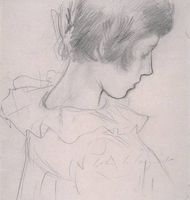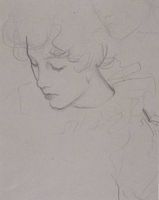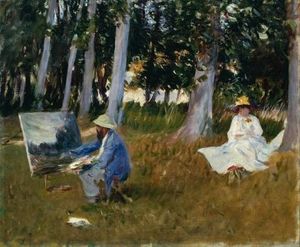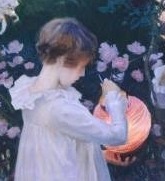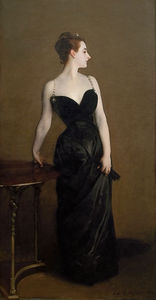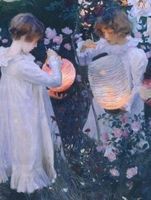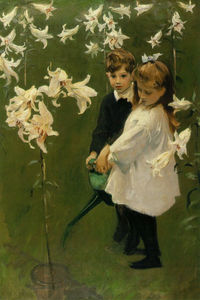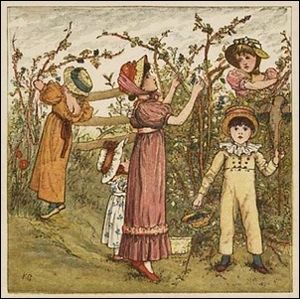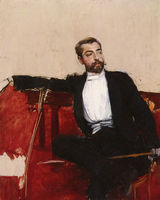Carnation Lily Lily Rose
- Date of Creation:
- 1886
- Height (cm):
- 174.00
- Length (cm):
- 153.70
- Medium:
- Oil
- Support:
- Canvas
- Subject:
- Figure
- Framed:
- Yes
- Art Movement:
- Realism
- Created by:
- Current Location:
- London, United Kingdom
- Displayed at:
- Tate Britain
- Owner:
- Tate Britain
- Carnation Lily Lily Rose Page's Content
- Story / Theme
- Inspirations for the Work
- Analysis
- Critical Reception
- Related Paintings
- Locations Through Time - Notable Sales
- Artist
- Art Period
- Bibliography
Carnation Lily Lily Rose Story / Theme
Sargent's friends of the time all attest to how much fun he had working on Carnation, Lily, Lily, Rose, which might have been why it took him almost two years to complete it.
Sargent painted Carnation, Lily, Lily, Rose in Cottonwood, a quaint English town that had once been a major stopping point for horses but declined with the advent of the railroad in the mid-1800s. The town was rediscovered in the 1800s by artists and it was an epoch of zany self-discovery as the artists probed the countryside and their own artistic limits. They were very fond of the lighthearted song "The Wreath," whose refrain asks the question 'Have you seen my Flora pass this way?' to which the answer is 'Carnation, Lily, Lily, Rose'.
Sargent's inspiration for this painting came from a boating trip that he took along the Thames River, in which he saw Chinese lanterns hanging among trees and lilies.
Sargent worked on this composition in the Impressionist manner, using natural light in natural settings (outdoors). However, because that magical moment between sunrise and sunset only happened for a few moments each day, Sargent was forced to paint only for these few minutes each day.
The artist would play tennis with his friends until the light was just right outside. Then he would sit by the easel and paints he had already set up. First, he would place himself at a distance from the canvas, then, when the light hit the canvas in a certain way he would dash to it and paint for a few moments.
Sargent also made many preliminary sketches of the girls, more perhaps than any other of his works.
Carnation Lily Lily Rose Inspirations for the Work
Although considered a Realist, during his late twenties Sargent became increasingly enamored by the Impressionist style which originated in Paris, where he completed his artistic training. Sargents' growing interest in this artistic style is revealed by the number of Impressionist exhibitions he attended during the mid-eighties. The Impressionists were known to concentrate on the effects of light over the passage of time and this focus is evident in Carnation, Lily, Lily, Rose.
Sargent even visited noted Impressionist painter Monet in 1885 and painted a portrait of him in the Impressionist style. The emphasis on the aesthetic look of Carnation, Lily, Lily, Rose at the expense of all narrative or moral concern shows the influence of the Aesthetic movement that was quite popular in Britain at this time. Aestheticism was based on aesthetic value (beauty) rather than moral and social themes and its popularity also extended to literature and interior design.
Carnation Lily Lily Rose Analysis
Sargent sought to have an accurate rendering of light and color in an outdoor painting which was a goal of the Impressionists or, like Sargent, Impressionist-inspired artists of the time.
Sargent wanted to appeal to a British audience but at the same time retain elements of his Impressionism-inspired style and show of technical virtuosity. Impressionism was based on capturing things in the moment and it was one of the early modern styles. However, it used the aesthetic style popular in Britain at the time, where beauty was sufficient as a theme and there was no need for moral and social messages.
The way Carnation Lily, Lily, Rose was created was rather unusual; it was not intended to capture the most perfect sunset but more the affect that this perfect sunset has, in terms of color, shadows, and light.
Lighting:
The lighting in this canvas successfully shows the moment in the day where the sun has started setting and twilight and daylight are at equal effect with each other, their unity offset by the orange glow of the lanterns which provides a surreal contrast. The flowers skillfully reflect both the dusk and the lanterns.
Use of space:
At first glance Carnation Lily, Lily, Rose lacks unity: the eye is drawn to so many aspects of the composition: the brilliant clash of light and color of the girls, the vegetation, and the lantern. Although framed by the vegetation, the girls are also removed from it: their white gowns and movements are still, while the grass swirls around their feet and the flowers curl around. The girls are depicted in a shallow space while the surrounding vegetation and lanterns are abstract.
The painting is from a small persons' perspective. The lilies are outsized as if the viewer is seeing them through the eyes of a child, and the light from the Chinese lanterns casts a magical glow over the scene.
Color:
The orange glow of the lanterns reflects on the girls' faces and their white gowns and these peachy shades stand out against shadowy green tones. Colors are everywhere in this canvas and range from pinkish-white to burgundy and yellow.
Tone/mood/emotions elicited:
This painting portrays the innocence of childhood and the two girls look small in the big garden surrounding them. Their downward gazes and positions are turned away from the viewer and they are completely focused on what they are doing.
Carnation Lily Lily Rose Critical Reception
Sargent moved to London from Paris in 1885 partly for career reasons and partly because his unveiling of the portrait Madame X caused such a scandal that Parisians were afraid to be painted by him. The reception he received from the British art world was not a warm one. His paintings were considered "eccentric" and "Frenchified". It was in this hostile atmosphere that he submitted Carnation Lily, Lily, Rose.
Carnation Lily, Lily, Rose is heavily influenced by Impressionism, the movement that was devoted to painting things as they appeared in the moment, out of the studio, and in natural light. The British art world viewed this style as a threat to their school of paintings. Impressionism emerged in France but many British painters had adopted its techniques by the time Sargent began painting Carnation Lily, Lily, Rose in 1885. However, this did not stop the British from viewing Impressionism as a "French" - and therefore radicalstyle.
Once unveiled, Carnation Lily, Lily, Rose became the talk of the exhibit. Even scholars who were hostile to Impressionism could not help but be impressed by Sargent's remarkable technical skill in executing the effect of light at dusk. However, they dismissed his wondrous, aesthetically-pleasing composition as being nothing more than 'cheap and clever tricks'. Accustomed to scenes from classical mythology or other such edifying historical topics, many critics admired the scene of two little girls lighting lanterns in a garden but questioned whether or not it was worth doing.
The most notable thing about the response to Carnation Lily, Lily, Rose, was not what the critics said but how much they talked about the canvas. Despite objections form some of its members, the British Royale Academy purchased this painting almost immediately after the show ended. Whereas Sargent previously lacked for portrait commissions, he was inundated with requests. For the first time, his reputation spread to the United States. Carnation Lily, Lily, Rose launched his career on two continents - an enormously successful career which did not flag until his death.
Carnation Lily Lily Rose Related Paintings
Carnation Lily Lily Rose Locations Through Time - Notable Sales
The painting was bought for an undisclosed sum by the British Royale Academy almost as soon as its 1886 exhibition closed. It was hung in the Tate Gallery, the official national gallery for British art, where it can still be seen today.
Carnation Lily Lily Rose Artist
Sargent's Impressionist-inspired works, such as Carnation, Lily, Lily, Rose, have received equal critical reception, but he is not as well-known for this style. Sargent painted Carnation, Lily, Lily, Rose after he moved to Britain from France. Although not considered French because of his American parentage, Sargent was treated with suspicion by the British because of his French training.
It was hard for him to find patrons because many considered his works to be "strange" and "Frenchified. " Many critics consider Carnation, Lily, Lily, Rose, to be Sargents' attempt to tone down his French Impressionist style and appeal to the British art public. If that was his goal, it worked spectacularly because after the exhibition of Carnation, Lily, Lily, Rose, Sargent never had a problem finding patrons, British or otherwise.
Carnation Lily Lily Rose Art Period
Although a realist, Sargent flirted with Impressionist techniques during his late twenties and early thirties. Impressionist paintings are known for having a sketchy quality which, upon close examination, dissolve into gobs of paint. While Sargent did not take the technique to this extreme, Carnation, Lily, Lily, Rose does use several Impressionist techniques. The paintings' focus on the beauty of the setting, without any obvious moral or social messages, puts this canvas into the Aesthetic, as well as Impressionist camp. The Aesthetic movement focused purely on the beauty of the object/subject in the painting.
Carnation Lily Lily Rose Bibliography
You can find out more about this and other works of Sargent by referring to the literature recommended below.
Books:
• Charteris, Evan. John Sargent (1927, reprinted 1972)
• Charles Merrill Mount, John Singer Sargent, 3rd ed. (1969)
• Stanley Olson, John Singer Sargent, His Portrait (1986, reissued 1989)
• Ormond, Richard. John Singer Sargent: Paintings, Drawings, Watercolors (1970)
• Ratcliff, Carter John Singer Sargent (1982)
• Hills, Patricia et al. , John Singer Sargent (1986)


